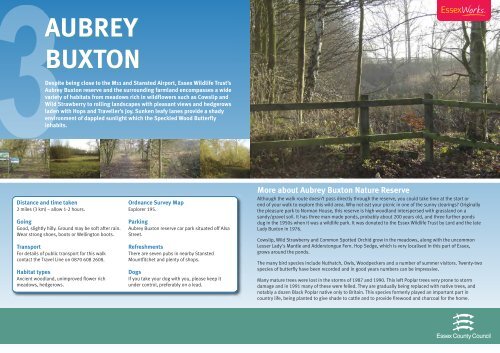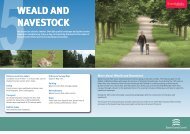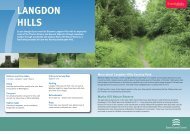Aubrey Buxton Nature Reserve - Essex County Council
Aubrey Buxton Nature Reserve - Essex County Council
Aubrey Buxton Nature Reserve - Essex County Council
You also want an ePaper? Increase the reach of your titles
YUMPU automatically turns print PDFs into web optimized ePapers that Google loves.
AUBREY<br />
BUXTON<br />
Despite being close to the M11 and Stansted Airport, <strong>Essex</strong> Wildlife Trust’s<br />
<strong>Aubrey</strong> <strong>Buxton</strong> reserve and the surrounding farmland encompasses a wide<br />
variety of habitats from meadows rich in wildflowers such as Cowslip and<br />
Wild Strawberry to rolling landscapes with pleasant views and hedgerows<br />
laden with Hops and Traveller’s Joy. Sunken leafy lanes provide a shady<br />
environment of dappled sunlight which the Speckled Wood Butterfly<br />
inhabits.<br />
Distance and time taken<br />
2 miles (3 km) – allow 1-2 hours.<br />
Going<br />
Good, slightly hilly. Ground may be soft after rain.<br />
Wear strong shoes, boots or Wellington boots.<br />
Transport<br />
For details of public transport for this walk<br />
contact the Travel Line on 0870 608 2608.<br />
Habitat types<br />
Ancient woodland, unimproved flower rich<br />
meadows, hedgerows.<br />
Ordnance Survey Map<br />
Explorer 195.<br />
Parking<br />
<strong>Aubrey</strong> <strong>Buxton</strong> reserve car park situated off Alsa<br />
Street.<br />
Refreshments<br />
There are seven pubs in nearby Stansted<br />
Mountfitchet and plenty of shops.<br />
Dogs<br />
If you take your dog with you, please keep it<br />
under control, preferably on a lead.<br />
More about <strong>Aubrey</strong> <strong>Buxton</strong> <strong>Nature</strong> <strong>Reserve</strong><br />
Although the walk route doesn’t pass directly through the reserve, you could take time at the start or<br />
end of your walk to explore this wild area. Why not eat your picnic in one of the sunny clearings? Originally<br />
the pleasure park to Norman House, this reserve is high woodland interspersed with grassland on a<br />
sandy/gravel soil. It has three man-made ponds, probably about 200 years old, and three further ponds<br />
dug in the 1950s when it was a wildlife park. It was donated to the <strong>Essex</strong> Wildlife Trust by Lord and the late<br />
Lady <strong>Buxton</strong> in 1976.<br />
Cowslip, Wild Strawberry and Common Spotted Orchid grow in the meadows, along with the uncommon<br />
Lesser Lady's Mantle and Adderstongue Fern. Hop Sedge, which is very localised in this part of <strong>Essex</strong>,<br />
grows around the ponds.<br />
The many bird species include Nuthatch, Owls, Woodpeckers and a number of summer visitors. Twenty-two<br />
species of butterfly have been recorded and in good years numbers can be impressive.<br />
Many mature trees were lost in the storms of 1987 and 1990. This left Poplar trees very prone to storm<br />
damage and in 1991 many of these were felled. They are gradually being replaced with native trees, and<br />
notably a dozen Black Poplar native only to Britain. This species formerly played an important part in<br />
country life, being planted to give shade to cattle and to provide firewood and charcoal for the home.
© <strong>Essex</strong> <strong>County</strong> <strong>Council</strong><br />
Lord <strong>Aubrey</strong> <strong>Buxton</strong><br />
<strong>Aubrey</strong> <strong>Buxton</strong>, the co-founder<br />
of Anglia Television was greatly<br />
influenced by an interest in wildlife.<br />
He established the local<br />
‘Countryman’ series which<br />
went on to become the ‘Survival’<br />
programme which took the viewer<br />
from the Galapagos Islands to<br />
Tibet. However, <strong>Aubrey</strong> retained an<br />
interest in local wildlife and the first<br />
programme of the Survival series<br />
was based in London. Due to his<br />
involvement with conservation<br />
organisations for 50 years and his<br />
chairmanship of ITN he became<br />
Lord <strong>Buxton</strong>. The <strong>Essex</strong> Wildlife<br />
Trust reserve has also been named<br />
after him.<br />
Wild Hops<br />
Masses of rough and shaggy Hop<br />
leaves can be seen in the<br />
hedgerows which run alongside<br />
the footpaths. Hops are a well<br />
known ingredient of beer, but the<br />
fibres are also used to make<br />
clothing and the young shoots<br />
can be cooked and eaten, a<br />
favourite dish of the Italians is<br />
‘Hops and Tagliatelli’!<br />
Gall End<br />
Brickyard<br />
Plantation<br />
To Stansted<br />
Mountfitchet<br />
Stansted<br />
Mountfitchet<br />
Stansted means ‘stony<br />
place’ in Saxon and predates<br />
the Norman<br />
invasion of England,<br />
although it wasn’t until<br />
the invasion that the<br />
suffix Mountfitchet was<br />
added from the Norman<br />
baron who settled in<br />
the area. Very few<br />
remnants of the baron’s<br />
castle remain but the<br />
area boasts a<br />
reconstruction of an<br />
early Norman castle.<br />
<strong>Nature</strong> <strong>Reserve</strong><br />
Alsa Street<br />
Norman<br />
House<br />
Alsa Lodge<br />
Coppiced Hazel<br />
Along some of the footpaths<br />
you will see coppiced Hazel<br />
trees (all branches coming<br />
up from a central ‘stool’).<br />
The coppiced branches of<br />
Hazel are thin and easily<br />
twisted and are woven<br />
together to make hurdles, in<br />
a similar way to Willows.<br />
Veteran Oaks<br />
Veteran Oaks are defined<br />
by wildlife enthusiasts as<br />
‘trees of interest<br />
biologically, aesthetically or<br />
culturally because of their<br />
age’. Ancient Oaks can be<br />
very important for fungi<br />
and dead wood<br />
invertebrates such as<br />
beetles. It is quite often<br />
tidied away when it would<br />
be more beneficial for<br />
biodiversity if it was left to<br />
rot on the ground.





